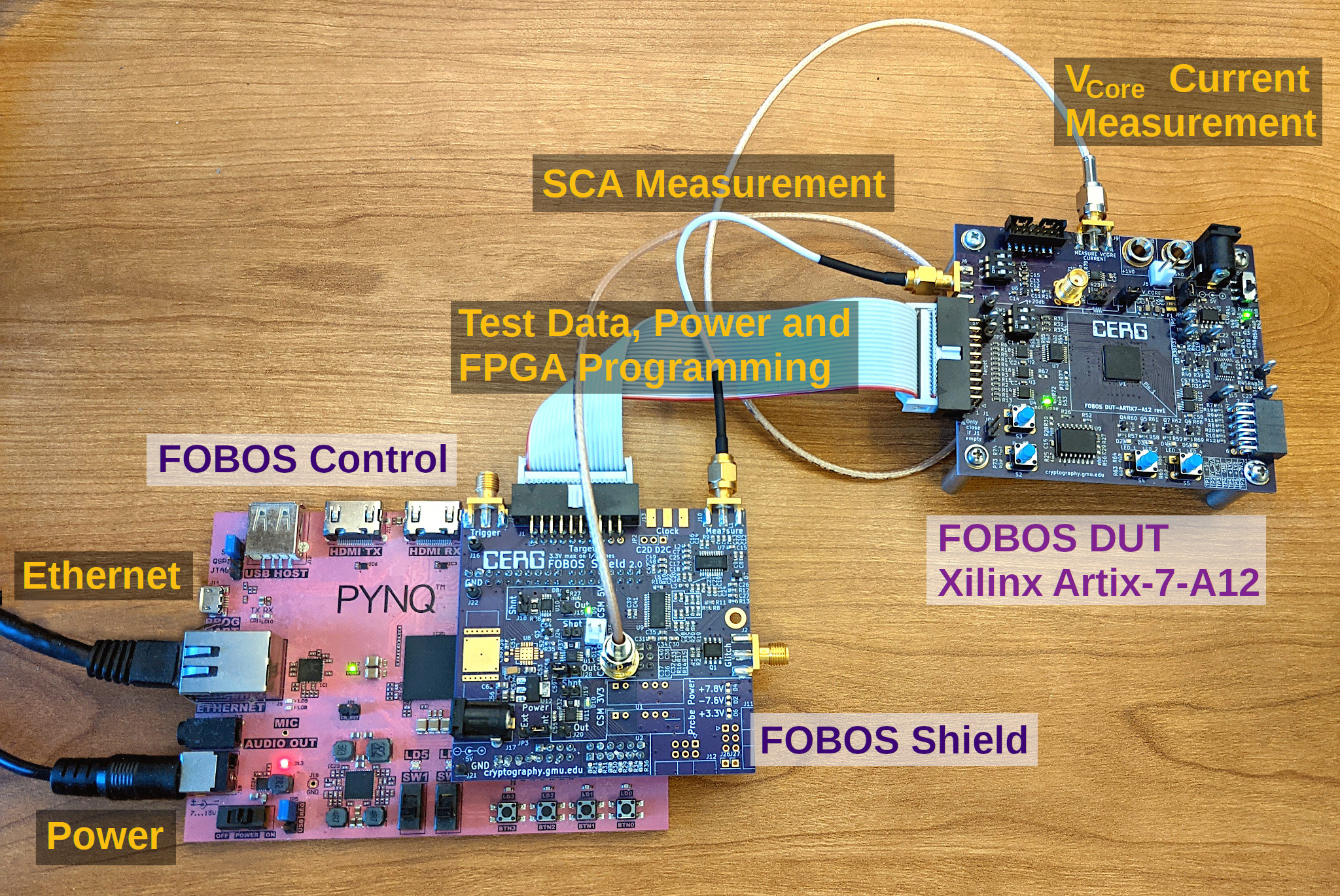1. Introduction
The Flexible Opensource workBench fOr Sidechannel analysis (FOBOS) loosely named after the Greek god Phobos (Φóβος), is an “acquisition to analysis” solution which includes all necessary software to control the Device Under Test (DUT), obtain the measurements and analyze them using several power analysis techniques. FOBOS mainly targets FPGAs as DUTs. The system is targeted for educational and research purposes.

Fig. 1.1 FODOS 3 Setup with Artix7-A12 DUT
1.1. FOBOS Overview
The main components of the FOBOS 3 platform are as follows:
The SCA Workstation hosts capture and analysis scripts using a JupyterLab installation. All scripts are written in Python and are commented and easy to modify. In typical system usage, the user runs capture scripts that send test vectors (e.g., key and plaintext) one at a time to the connected control board and receives the results (e.g., ciphertext) and power traces. Analysis scripts can be run on the saved results and traces or optionally executed simultaneously with trace collection.
The control board receives a test vector from the SCA workstation and forwards it to the DUT. The control board asserts a trigger signal as soon as the target board starts operating on the test vector (i.e., running the cryptographic function). This signal can trigger an external oscilloscope or the internal ADC hosted on the FOBOS Shield. The control board also generates the target clock. The internal ADC can sample changes in the power consumption of the target board at a maximum rate of 100 M Sample/sec. The sampling clock and the target clocks are synchronized to achieve high-precision measurements.
The DUT hosts the cryptographic function that is being evaluated. The DUT board is designed (or modified) to allow measurement of the power consumption using a shunt resistor or a current probe. We tested the platform using a modified Digilent Nexys 3 board featuring a Xilinx Spartan-6 FPGA, the NewAE CW305 Artix-7 target board, and our upcoming FOBOS Artix-7-based DUT.
1.2. Feature Overview
Runs cryptographic implementations on FPGAs and measures power consumption.
Provides a simple wrapper for FPGA implementations of cryptographic algorithms according to the CAESAR and LWC Hardware APIs.
Separate control and DUT boards allowing easy addition of new DUTs.
Uses commercial over-the-shelf boards when possible to reduce cost.
Digilent Pynq-Z1 and TUL Pynq-Z2 control boards.
DUT support includes Digilent Nexys3 board (Xilinx Spartan6), FOBOS FBD-A7 and NewAE CW305 (Xilinx Artix7 boards).
Adjustable DUT clock.
DUT clock synchronized with ADC clock.
Adjustable trigger signal.
Supports fast USB3-based oscilloscopes (Picoscope).
Software to perform Correlation Power Analysis (CPA).
Leakage assessment using t-test.
1.3. Changelog
Version 3.0.1
Substantial documentation updates and improvements
Power calibration works again (was working on beta versions of FOBOS 3)
MTDs of each key byte are now written into a file, they don’t have to be guessed from graphs anymore
Updated fobosTVGen to handle more FIFOs
XILINX_XRT environment variable on Pynq was not set correctly
Pynq install script now detects which Pynq board it is running on
FOBOS can now set fixed amplification on the amplifier of the FOBOS Shield using ADC_hilo
Improved Makefile for building the Pynq overlay for Pynq-Z1 and Pynq-Z2, and different revisions of the FOBOS Shield
Version 3
Completely new version of FOBOS with major changes
FOBOS Shield which provides 100 MS/s ADC for SCA measurements and current sense monitors for power consumption measurements. This removes the need for an oscilloscope and enables benchmarking of power and energy consumption of the DUT.
Digilent Pynq-Z1 and TUL Pynq-Z2 control boards provide fast data aquisition and communication with the DUT through 1G Ethernet interface.
JupyterLab front end to control FOBOS. This also enables remote access.